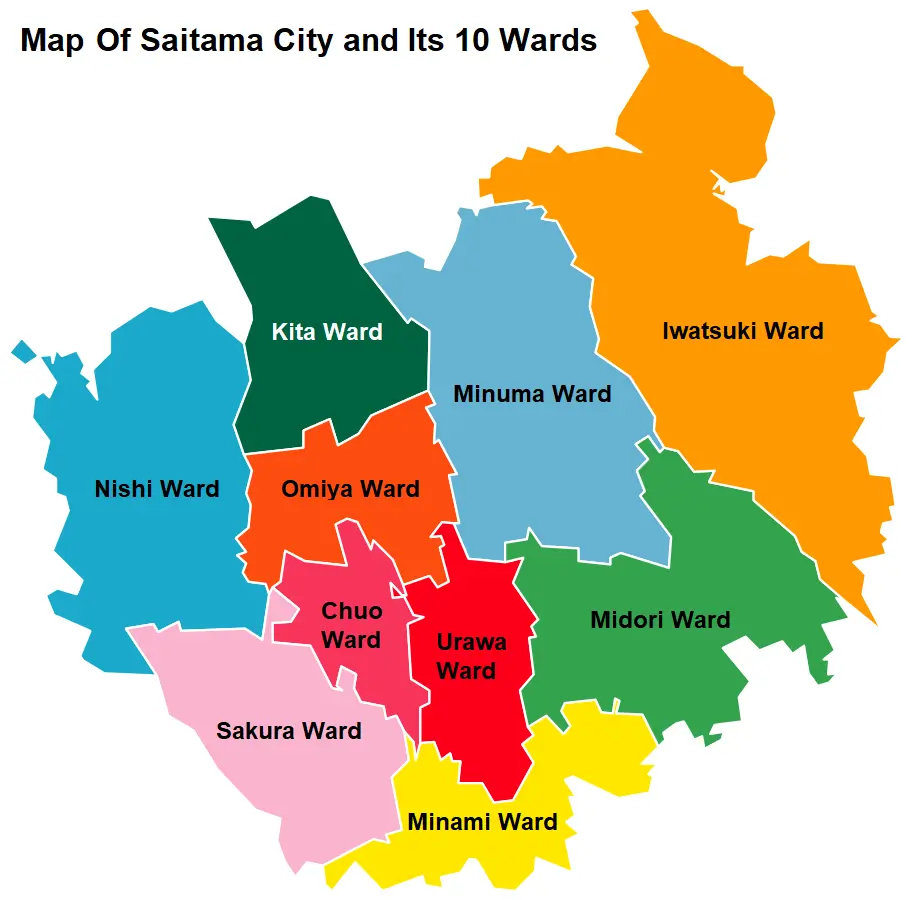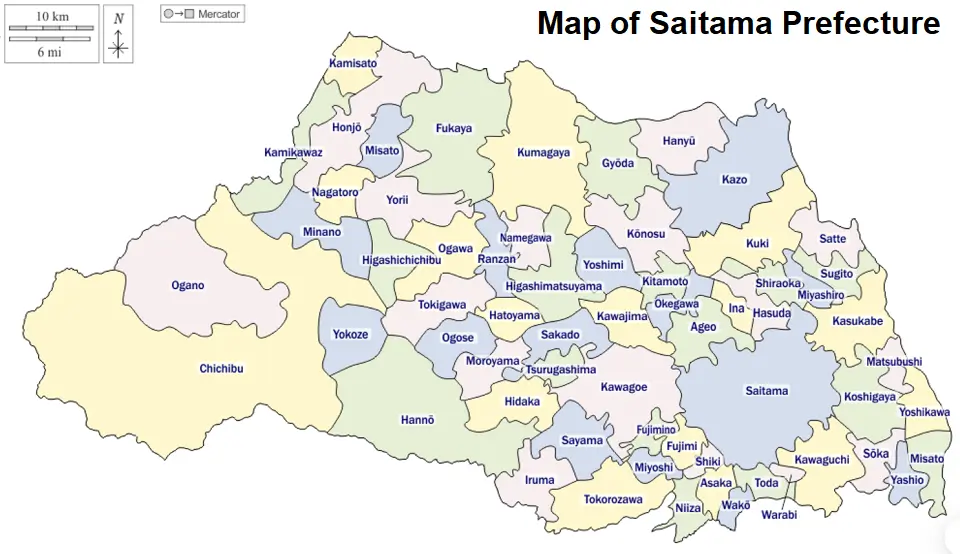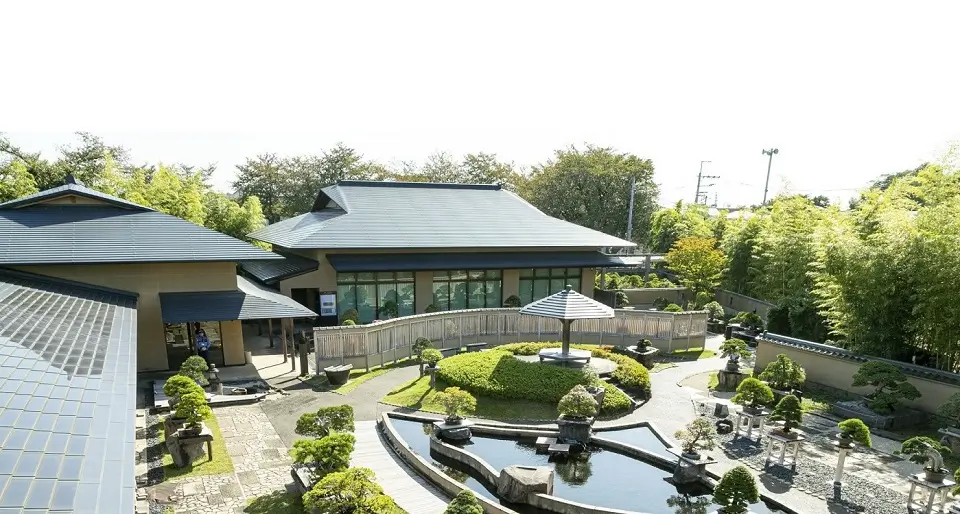A Guide to Living in Saitama Prefecture

Saitama Prefecture (埼玉県) is a popular area for many people working in the Tokyo Metropolis because of its proximity to Tokyo and its advantages over living in Tokyo. Let’s see how life is in Saitama and the best places to live and see in this prefecture
Saitama Prefecture is a landlocked region in the Kanto region on the island of Honshu. It is part of the Tokyo Metropolitan area and is north of Tokyo. The prefecture shares borders with Chiba, Ibaraki, Gunma, Nagano, Yamanashi, and Tokyo prefectures.
According to the January 2020 census, Saitama’s population was 7,344,765, and according to October 1, 2023 estimates, it was 7.331 million people, making it one of the most populous prefectures in Japan.
Saitama is known for its diverse landscapes, which range from urban centers to rural areas, and beautiful natural scenery. The prefecture is home to various mountains, rivers, and parks, offering numerous outdoor recreational opportunities. Some notable natural attractions in Saitama include Chichibu-Tama-Kai National Park, Nagatoro Valley, and Hitsujiyama Park, famous for its beautiful Shibazakura (moss phlox) blooms in spring and the vibrant green tea fields of Sayama.
Saitama was part of the ancient Musashi Province, and it has a rich history and cultural heritage. The prefecture is dotted with temples, shrines, and historical sites, such as the Kawagoe Castle, Hikawa Shrine, and Omiya Bonsai Village, renowned for its exquisite bonsai tree collection.
Saitama is also known for its local cuisine, including dishes like Hiyajiru Udon, a cold udon noodle soup, and Misaka Mochi, a grilled rice cake. The prefecture also has several traditional crafts, such as Iwatsuki Ningyo (Iwatsuki dolls) and Yazaemon Japanese pottery.
Pros and Cons of Living in Saitama
While ultimately, personal preferences, lifestyle, and priorities will determine which location best suits an individual or family, let us discuss the pros & cons of living in Saitama.
Pros
Living in Saitama Prefecture offers several advantages over living in Tokyo, although individual preferences may vary. Some of the key benefits of living in Saitama include the following:
Lower cost of living:
Saitama generally has a lower cost of living than Tokyo, particularly in terms of housing. Rent and property prices are usually more affordable in Saitama, providing more spacious living options than the limited space in Tokyo’s apartments. Depending on the size and location, rent can run around ¥65,000 in Saitama for a single person.
Proximity to nature:
Saitama boasts a variety of natural attractions, such as mountains, rivers, and parks. Residents can enjoy easy access to outdoor recreational activities like hiking, cycling, and river rafting, providing a balanced lifestyle between urban conveniences and natural surroundings.
Less crowded:
Although Saitama is still a populous prefecture, it tends to be less crowded than Tokyo, allowing for a more relaxed and less hectic lifestyle. This can lead to less stress, shorter commutes, and a more comfortable living environment.
Rich cultural heritage:
Saitama has many historical sites, temples, and shrines that showcase its rich history and cultural heritage. This provides residents with opportunities to explore and appreciate local traditions and customs.
Proximity to Tokyo:
As a major transportation hub between Tokyo and Nikko during the Edo period, Saitama retains its reputation as an urban commuter center. Many parts of Saitama are just 30 minutes from Tokyo’s major train stations.
Saitama’s well-developed transportation network ensures easy access to Tokyo for work, shopping, or entertainment. This means residents can enjoy the benefits of living in a less crowded area while still having convenient access to the opportunities and excitement of the capital city.
Family-friendly environment:
Saitama’s lower population density and more affordable housing options make it attractive for families. The availability of parks, recreational facilities, and spacious living areas can create a more comfortable environment for raising children.
Well-Developed Public Infrastructure:
The prefecture has experienced significant urbanization and industrial development, with cities such as Kawaguchi, Kawagoe, and Tokorozawa serving as major commercial and industrial hubs.
Cons
While Saitama offers numerous advantages, some people might still prefer the vibrant atmosphere and extensive amenities of Tokyo, and by living in Saitama, they would miss out on these aspects. The slower pace of life and lesser amenities than Tokyo has earned Saitama the reputation of Tokyo’s less fun cousin.
Saitama may not be an ideal place to live for people who prefer an urban lifestyle to a suburban one.
Where to Live in Saitama
Saitama prefecture offers many choices for an area to live in depending on personal preferences and any constraints such as the overall cost of living. The central areas in Saitama city will offer more amenities with a relatively higher cost of living and relatively faster city life. However, apart from the 10 wards of Saitama City, smaller cities in the Saitama prefecture offer relatively more peaceful slower life with a lesser cost of living. Some of the good options for living in Saitama prefecture are as follows:

Living in Downtown Wards
Omiya-Ku
Omiya-Ku, or Omiya Ward, is one of the ten wards of Saitama City, located in the southeastern part of the city. It was once a separate city known as Omiya, which was merged with Urawa and Yono cities in 2001 to form the modern Saitama City.
Omiya Ward is downtown Saitama, with JR Shinkansen station connecting it to Tokyo, Osaka, and further to Hakata in Fukuoka and Hiroshima. Being a downtown area, the average rent in Omiya is relatively higher than in other places in Saitama but lower than in Tokyo. Depending on the location and age of the building, the average rent in Omiya ranges from JPY 1,915 per sqm to JPY 2,620. This means that a single person can find comfortable accommodation for JPY 55,000 to 60,000 per month.
Attractions of Omiya War
Omiya Ward is known for its railway history. It is home to the Omiya Railway Museum, which showcases various types of trains, including steam locomotives and shinkansen (bullet trains). The museum also features interactive exhibits, a miniature railway, and a train simulator, making it an exciting attraction for train enthusiasts and families alike.
Another notable attraction in Omiya Ward is the Omiya Bonsai Village, a famous bonsai community with a history dating back to the early 20th century. The village consists of several bonsai nurseries and the Omiya Bonsai Art Museum, where visitors can learn about the history and techniques of bonsai cultivation and admire the impressive collection of miniature trees.
Omiya Park is a large public park in the ward, offering a range of recreational facilities, including sports fields, playgrounds, and a zoo. The park is especially popular during the cherry blossom season when the hundreds of cherry trees lining the park’s pathways burst into bloom.
In addition to these attractions, Omiya Ward serves as a major transportation hub for the Saitama Prefecture and the greater Tokyo area. Several train lines pass through the Omiya Station, making it a convenient base for exploring other areas of interest within the region.
Urawa-Ku
Located in the central part of the city, Urawa Ward (Urawa-Ku) serves as an administrative center for Saitama Prefecture and is known for its cultural and recreational attractions.
The average rent in Urawa-Ku is slightly higher than in Omiya and ranges from JPY 2030 to 2460 per sqm.
Here are some points of interest in Urawa Ward:
- Saitama Prefectural Museum of History and Folklore: This museum showcases the history, culture, and folklore of Saitama Prefecture, with exhibits that include ancient artifacts, historical documents, and traditional arts and crafts.
- Besshonuma Park: A popular park with a large pond, walking paths, and recreational facilities such as sports fields, playgrounds, and a Japanese garden. The park is particularly beautiful when many trees bloom during the cherry blossom season.
- Urawa Reds: Urawa Ward is home to the Urawa Red Diamonds, a professional football club that competes in the J-League, Japan’s top football league. The team’s home games are played at the Saitama Stadium 2002, located in the neighboring Midori Ward but with strong ties to Urawa and its residents.
- Urawa Station: As a major transportation hub, Urawa Station offers easy access to other parts of Saitama City and the Greater Tokyo Area via several train lines, including the JR Keihin-Tohoku Line, the JR Utsunomiya Line, and the JR Takasaki Line.
- Shopping and dining: Urawa Ward features several shopping centers, department stores, and a variety of restaurants, offering residents and visitors a range of shopping and dining options.
In addition to these attractions, Urawa Ward is centrally located within Saitama City. Therefore, its location and convenient transportation options make it an ideal base for exploring other areas of interest within Saitama Prefecture and the Greater Tokyo Area.
Chuo-Ku
As the name suggests, Chuo-Ku is located in the central part of Saitama City and covers an area of 14.50 square kilometers. As of September 2021, the estimated population of Chuo-Ku is around 164,100 people.
Chuo-Ku is a bustling urban center with many commercial and business areas, including the popular Cocoon City shopping complex. Chuo-ku ward is also home to several educational institutions, including Saitama University and Saitama Medical University.
One of the popular attractions in Chuo-Ku is the Omiya Bonsai Village, which is home to several nurseries and museums dedicated to the art of bonsai. The area also has several parks and green spaces, including Saitama City Central Park.
Chuo-Ku is served by several train and bus lines. This public transportation network includes the Tobu Tojo Line, the Saitama Rapid Railway Line, and the JR East Saikyo Line. The easy connectivity makes it easily accessible from other parts of Saitama City and Tokyo.
The average rent in Chuo Ward is similar to that of other central areas like Omiya and Urawa Wards.
Most Affordable Wards
Nishi-Ku
Nishi-Ku is located in the western part of Saitama City and covers an area of 21.17 square kilometers. As of September 2021, its estimated population is around 168,200 people.
Nishi-Ku is a primarily residential area with many shopping and commercial districts. These shopping facilities include the large Aeon Mall Omiya and the Nishikyubu Shopping Street. The ward also has several parks and green spaces, including Omiya Park and the Hikawa River Green Belt.
One of the popular attractions in Nishi-Ku is the Saitama Super Arena, a multi-purpose indoor arena that can accommodate up to 37,000 people. Throughout the year, it hosts various sports events, concerts, and other cultural events.
Nishi-Ku is served by several train and bus lines, including the JR Saikyo Line and the Tobu Noda Line, making it easily accessible from other parts of Saitama City and Tokyo.
The average rent in Nishi-Ku is among the most affordable in Saitama City, ranging from JPY 1,305 to 1,885 per sqm.
Midori-Ku
Midori-Ku is located in the northeastern part of Saitama City and covers an area of 53.21 square kilometers. As of September 2021, the estimated population of Midori-Ku is around 225,300 people.
Midori-Ku is primarily a residential area with many housing developments, parks, and green spaces. The ward is known for its large-scale residential communities, such as the Kawagoe Green City and Kawaguchi Green Heights. Midori-Ku also has several shopping areas, including the Aeon Mall Kawaguchi and the Kawaguchi Station East Exit Shopping Street.
One of the popular attractions in Midori-Ku is Shinrin Park, also known as Musashi-Kyuryo National Government Park. This large park features vast green spaces, various outdoor activities, and various seasonal events throughout the year. It also features several gardens, playgrounds, and cycling paths.
Midori-Ku is served by several train and bus lines, including the JR Saikyo Line and the Tobu Tojo Line. This easy connectivity makes it easily accessible from other parts of Saitama City and Tokyo.
Together with Nishi-Ku, the average rent in Midori-Ku is also one of the lowest compared to other wards of Saitama City. The average rent range for apartments in Midori-Ku is JPY 1320 to 1825 per sqm.
Other Cities of Saitama-Ken to Live in

Kawaguchi
Kawaguchi is a city located in Saitama Prefecture, Japan. Some of the brief highlights of Kawaguchi include:
- Skip City Visual Museum: A home to the Kawaguchi Science Museum “Science World“, the visual museum has several educational facilities.
- Kawaguchi Green Center: A large park with an artificial lake, a greenhouse, and a botanical garden.
- Shingashi River: A beautiful river with cherry blossom trees and a popular spot for boat tours.
- Saifuku-ji Temple: A Buddhist temple with a five-story pagoda and a beautiful garden.
- Kawaguchi City Cultural Exchange Center: A facility that promotes cultural exchange between Kawaguchi and its sister cities worldwide.
- Hikawa Shrine: A popular Shinto shrine that hosts various festivals throughout the year.
- Kawaguchi Lake Town: A large shopping mall with various shops, restaurants, and entertainment facilities.
- Kawaguchi Station: A major transportation hub with access to various train and bus lines.
The average rent in Kawaguchi City falls from JPY 1,715 to JPY 2,075 per sqm.
Warabi
Warabi is a city located in Saitama Prefecture, Japan. Some of the brief highlights of Warabi include:
- Warabi City Museum: This museum displays the city’s history and culture and has a collection of local artifacts.
- Warabi Shrine: A Shinto shrine with a long history and beautiful architecture.
- Warabi Fureai Park: A large park with various sports facilities, a playground, and a barbecue area.
- Warabi City Culture Hall: A facility that hosts various cultural events and performances, including concerts and plays.
- Warabi Station: A major transportation hub with access to various train and bus lines.
Like Kawaguchi, the average rent for accommodation in Warabi ranges from JPY 1,715 to JPY 2,075 per sqm.
Tokorozawa
The city of Tokorozawa is located in the southern region of Saitama, directly on the border between Tokyo and Saitama. Tokorozawa is surrounded by greenery and offers a more relaxed lifestyle. The Seibu Ikebukuro and Shinjuku Lines connect it to Tokyo. The Tokorozawa Aviation Memorial Park and Sayama Inariyama Park are popular attractions. It only takes 40 minutes to reach major stations like Ikebukuro and Shinjuku stations for under ¥500.
Some of the brief highlights of Tokorozawa include the following:
- Tokorozawa Aviation Memorial Park: A park with various aircraft on display, including a retired Boeing 747.
- Sayama Hills: A mountainous area with hiking trails and a beautiful city view.
- Belluna Dome: Also known as Belluna Dome, in front of the Seibukyūjō-mae Station is a baseball stadium that also hosts other events and concerts.
- Tokorozawa Sakura Town: A new entertainment complex with a museum dedicated to anime, a theme park, a hotel, and restaurants.
- Kadokawa Musashino Museum: This museum displays the city’s history and culture and has a collection of local artifacts.
- Tokorozawa Fudoson: A Buddhist temple with a large statue of Fudo Myoo, the deity of fire.
- Shin-Tokorozawa Parco: A large shopping mall with various shops and restaurants.
- Tokorozawa Station: A major transportation hub with access to various train and bus lines.
The average accommodation rent in Tokyorozawa City is in the range of J{Y 1,715 to JPY 2,075 per sqm.
Koshigaya
Some of the brief highlights of Koshigaya include:
- Koshigaya Lake Town: A large shopping mall with various shops, restaurants, and entertainment facilities.
- Koshigaya Park: A park with a large pond, a botanical garden, and a playground.
- Saitama Super Arena: A multipurpose indoor arena that hosts various sports events, concerts, and other shows.
- Koshigaya City Museum: This museum displays the city’s history and culture and has a collection of local artifacts.
- Koshigaya City Jidokan Cosmos: Here, children can experience science experiments, arts and crafts, and workshops. The facility also has a planetarium.
- Kitamoto Nature Observation Center: A facility that offers nature observation programs and workshops.
- Koshigaya Sports Center: A large sports facility with various courts, a swimming pool, and a gym.
- Washinomiya Shrine: A Shinto shrine that became famous due to its appearance in the anime series “Lucky Star.”
- Koshigaya Station: A major transportation hub with access to various train and bus lines.
The average rent range for accommodation in Koshigaya is JPY 1,788 per square meter, the same as that in the other cities in the Saitama prefecture mentioned above.
Soka
Some of the brief highlights of Soka are as follows:
- Soka Matsubara: A long row of pine trees symbolizing the city and a popular spot for cherry blossom viewing.
- Soka Station: A major transportation hub with access to various train and bus lines.
- Soka Park: A park with a large pond, a playground, and a walking trail.
- Soka City Museum: This museum displays the history and culture of the city and has a collection of local artifacts.
- Soka International Festival: An annual festival that celebrates the diverse cultures of Soka’s international community.
As mentioned above, the average rent in Soka City is the same as that in most other cities of Saitama prefecture: JPY 1,715 to JPY 2,075 per sqm.
Sightseeing Around Saitama Prefecture

(Picture: Saitama Omiya Bonsai Art Museum – picture courtesy: Japan National Tourism Organization)
Tokyo is obviously the main attraction for visitors and residents in the Kanto region, but that doesn’t mean that Saitama has nothing to offer—the numerous hiking trails, flower parks, and historic towns. Anime lovers will be especially glad to know that several locations here have inspired some of Japan’s most beloved films.
Totoro Forest
With scenery that directly inspired the Ghibli 1988 movie “My Neighbor Totoro.” Totoro Forest also has beautiful hiking trails through the southern region of the prefecture. If you love hiking and tracking, please do not miss this article about hiking in Japan.
Along the hiking trail, you’ll be able to visit several shrines and, in the end, be able to visit Kurosuke’s House. It was built as a traditional Japanese-style house over 100 years ago. Admission to the house is free, and it offers original Totoro souvenirs for purchase. All proceeds go to upkeep the house and protect the forest.
Moominvalley Park and Metsa Village
In Hanno City, Moominvalley Park is an official theme park dedicated to the beloved character Moomin. Visitors can experience live performances and exhibitions and shop for exclusive Moomin souvenirs. The adjacent area, Metsa Village, is located by a scenic lake. Here, you can enjoy free time like people in the Nordic region.
Kawagoe
Originating from the Edo period, Kawagoe was a bustling commercial supply town. Its central position allowed the city to grow strong as a trade city, supplying Tokyo until about 100 years ago. Although the city has since lost its original purpose, many Edo buildings have been remodeled to keep the historical air in the town. Some town highlights include Kitain Temple, Honmaru Goten, and the Kawagoe Hikawa Festival.
Nagatoro
The mountains of western Saitama are some of Japan’s most beautiful natural scenery. Nagatoro is a popular destination for day-trippers out of Tokyo who are interested in riverboat cruises, hiking, and water sports. The Arakawa River flows between Tokyo and Saitama, offering beautiful natural scenery and a huge rock formation called Iwadatami.
Kadokawa Museum
A fusion of art, culture, and a library wrapped up into one building. Recently opened in August 2020, the Kadokawa Museum has become a popular tourist site for those seeking a fusion between art and anime. Japan’s largest publishing company, Kadokawa, holds its exhibition inside, featuring past publications of their anime and manga magazines. The upper floor holds the library with thousands of books to read and experience leisurely.
Conclusion
Saitama is a great place to live because it’s close to the big city of Tokyo. Moreover, it is usually quieter and less busy. This means you can easily commute to work in Tokyo and then return to a peaceful area. In fact, the commuting time and cost from many areas of Saitama and Tokyo will not be much higher than if you are living in Tokyo.
Moreover, in Saitama, homes are often bigger and cost less than in Tokyo. There are also many beautiful parks and natural spots to explore and enjoy. Plus, there are many interesting historical places to visit and learn from. Best of all, it’s easy to travel between Saitama and Tokyo because of the efficient connectivity by buses and trains.

A bilingual native Japanese, Naoko accumulated 14 years of experience in multinational companies’ diverse fields like HR, accounting, and sales support after graduating from the State University of New York. She is a co-founder of ReachExt K.K. and EJable.com.
